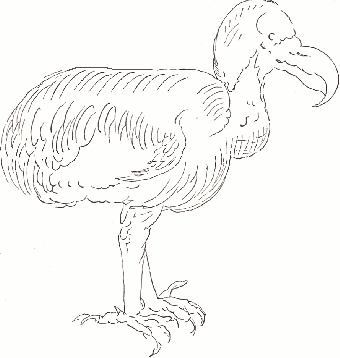
Dodo Picture
From a tracing by Professor
Schlegel of the origiual drawing in a MS journal kept during Wolphart Harmanszoon's
voyage to Mauritius (A.D. 1601-1602)
|
A diary, which was kept by
one of the captains of the other fleet, was published which confirmed
the details already gained by other voyages. In addition it mentioned that
the Dodo was now called Dodaarsen by some, and alternatively known
as Dronten by others. Professor Schlegel later indicated
that Dodaarsen was a name also used by the Dutch for the Little
Grebe or Dabchick, a bird which the Dodo reminded them of by the Dodo's
rounded rear and small tuft of a tail. It was suggested by a
Dr. Jentink in the 19th Century that, Dronten,
which has been naturalized in France as Dronte,
may be from the
obsolete Dutch verb dronten (cognate with drenten aud drinten),
to
be swollen (cfi Verwijs and Verdam, Middelnederlandsch Woordenboek,
ii.
col. 435), and would indicate the Dodo's figure as represented by some
draughtsmen, and as described by Sir Thomas Herbert (born 1606 and died1682).
The aforementioned Clusius
stated that he saw at Pauw's House in Leyden in 1605 the foot of a Dodo
which he described in great detail. A number of paintings
of Dodos were made by the Flemish Artist Roelandt Savery (born at Courtenay
in 1576 and died in 1682). At least those painted by him dated 1626
at Berlin, and 1628 at Vienna are believed to have been painted with living
Dodos as the subject. Similarly, a picture made by Goiemare dated
1627 is thought to be of a captive live Dodo.
A painting of a Dodo by Dutch
Court artist and Engraver Joris Hoefnagel, also known as Georg Hoefnagel
(born around 1545 and died 1601), is believed to be dated even earlier
than Savery's paintings of the bird. During his time in the service
of the eccentric and reclusive Emperor Rudolf II of (1552-1612), Hoefnagel
painted numerous pictures of the emperor's animals which were kept in a
menagerie at the Emperor's Schloss Neugebau near Viena, or at the
Schloss Ebersdorf. One of these is a painting of a Dodo and is virtually
certain to had been painted before 1626 (the majority of Hoefnagel's paintings
for the Emperor having been done between 1602 and 1610). It is thought
that the part of the head of a Dodo which was found around 1850 in a the
Museum at Prague had been part of the Emperor Rudold II's menagerie.
|





